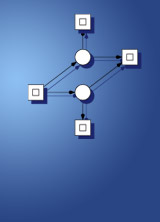
data structures and software dependability
computer science department
brandenburg university of technology cottbus - senftenberg
Einführung in die Nebenläufigkeit
Vorlesung, Prof. Dr.-Ing. M. Heiner, WS 2015/2016
latest update: October 15, 2015, at 09:56 AM
Materialien zur Vorlesung
Folien, Demo-Programme, Petrinetze;
- dunklere Felder enthalten zusätzliche/ergänzende Materialien zu dem in der Vorlesung behandelten;
- Die dunkelblaue Zeile zeigt den aktuellen Vorlesungsstand an. Materialien oberhalb dieser Zeile sind freigegeben, Materialien unterhalb dieser Zeile sind unverbindliche Vorinformationen.
| (1) Einführung, Motivation | dependability engineering of reactive systems.pdf (27 p.) |
| |
| (2) Einführung Petrinetze |
modelling with Petri nets.pdf (17 p.)
analysis with Petri nets.pdf (16 p.)
|
| |
| coverability graph.pdf (6 p.) | |||
|
(3) Grundlegende Prozeßkonzepte (3.1) Prozesse und Threads
|
Concurrency in Java | ||
|
stand alone version of ThreadDemo example by Magee&Kramer | |||
|
(3.2) Wechselwirkungen zwischen Prozessen
|
(1) Java (2) JavaFC | ||
|
(3.3) Semaphore als ADT
| |||
|
Garden: | |||
|
(3.4) Sperrsynchronisation (Konkurrenz)
mutex pattern
|
mutex pattern, analysis.pdf (26 p.)
invariant analysis, examples.pdf (28 p.)
|
no synchronization: Semaphore: | |
| |||
| informal introduction.sld2.pdf | ||
|
(3.5) Ereignissynchronisation (Kooperation)
| |||
| |||
|
(4) Kompakte Konstrukte | |||
| (5) Zusammenfassung | |||
| (6) Java 5.0 | |||
anstelle eines Schlusswortes
“Thread-safe code is code that will work even if many Threads are executing it simultaneously. Writing it is a black art. It is extremely difficult to debug since you can’t reproduce all possible interactions between Threads. You have to do it by logic. In a computer, something that happens only one in a billion times must be dealt with because on average it will happen once a second. To write code that will run stably for weeks takes extreme paranoia.”
[ source ]